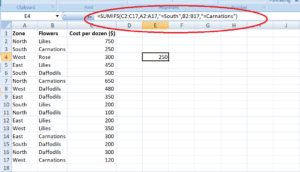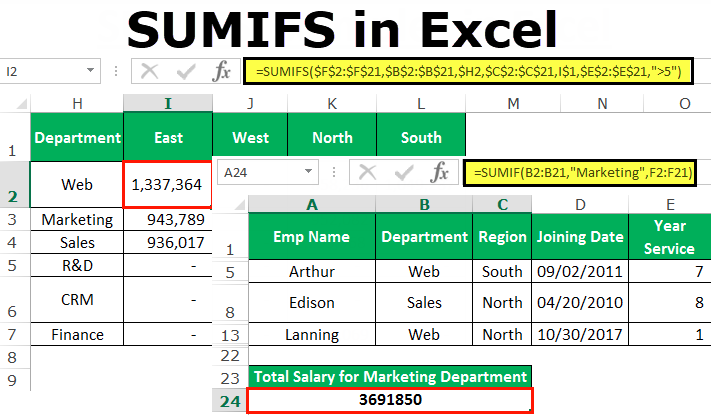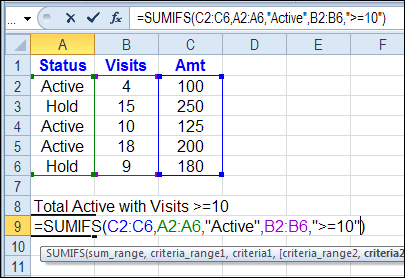Not known Factual Statements About Sumif Vs Sumifs
If "blank" suggests cells that include absolutely nothing - no formula, no zero length string returned by a few other Excel function, then make use of "=" as the criteria, like in the adhering to SUMIF formula: =SUMIF(A 2: A 10,"=", C 2: C 10) If "blank" consists of absolutely no size strings (for instance, cells with a formula like =""), after that utilize "" as the requirements: =SUMIF(A 2: A 10,"", C 2: C 10) Both of the above solutions evaluate cells in column An and if any vacant cells are found, the matching values from column C are added.


Usually, you make use of the SUMIF feature to conditionally sum values based on days in the very same way as you utilize message and also numerical requirements. If you intend to sum values matching to the dates that are better than, less than or equal to the date you specify, then use the Standard Solution Example Description Sum values based upon a specific date.
Sum values if an equivalent day is above or equivalent to a provided date. =SUMIF(B 2: B 9,">=10/29/2014", C 2: C 9) Amount values in cells C 2: C 9 if an equivalent day in column B is better than or equivalent to 29-Oct-2014. Amount values if a matching day is above a day in another cell.
In case you desire to sum worths based on an existing date, then you have to utilize Excel SUMIF in mix with the TODAY() feature as demonstrated listed below: Criteria Solution Instance Sum values based upon the existing day. =SUMIF(B 2: B 9, TODAY(), C 2: C 9) Sum values representing a previous day, i.e.
Get This Report on Sumif Multiple Columns
=SUMIF(B 2: B 9, "" & TODAY(), C 2: C 9) Sum values if a date happens in a week( i.e. today +7 days).=SUMIF (B 2: B 9, "="& TODAY( )+7, C 2: C 9) The screenshot listed below illustrates how you can make use of the last formula to find the total quantity of all items that ship in a week. In Excel 2007 and greater, you can additionally use the SUMIFS feature that permits numerous criteria, which is even a far better alternative. While the latter is the subject of our next post, an instance of the SUMIF formula adheres to listed below: =SUMIF(B 2: B 9, ">=10/1/2014", C 2: C 9) - SUMIF(B 2: B 9, ">=11/1/2014", C 2: C 9) This formula sums up the values in cells C 2: C 9 if a date in column B is between 1-Oct-2014 and 31-Oct-2014, inclusive.
The very first SUMIF function adds up all the cells in C 2: C 9 where the equivalent cell in column B is higher than or equivalent to the start day (Oct-1 in this instance). Then you just have to subtract any type of worths that drop after the end date (Oct-31), which are returned by the 2nd SUMIF feature.

Mean, you have a summary table of monthly sales. Given that it was combined from a varieties of regional reposts, there are a couple of records for the very same product: So, how do you discover the total of apples marketed in all the states in the previous three months? As you remember, the measurements of sum_range are determined by the measurements of the variety criterion.
This is not what we are searching for, right? The most sensible and also simplest remedy that suggests itself is to create an assistant column that calculates specific sub-totals for each row and afterwards reference that column in the sum_range requirements. Proceed as well as place an easy AMOUNT formula in cell F 2, after that fill down column F: =SUM(C 2: E 2) Afterwards, you can create a normal SUMIF formula such as this: =SUMIF(A 2: A 9, "apples", F 2: F 9)or=SUMIF(A 2: A 9, H 1, F 2: F 9) In the above formulas, sum_range is specifically of the same size as array, i.e
Not known Facts About Sumif Vs Sumifs
. There could be a number of reasons why Excel SUMIF is not helping you. Occasionally, your formula does not return what you anticipate only since the information key in a cell or in some disagreement isn't suited for the SUMIF function. So, here is a list of things to inspect. The first (variety) and also 3rd (sum_range) parameters of your SUMIF formula should constantly be an array reference like A 1: A 10.
Right formula: =SUMIF(A 1: A 3, "flower", C 1: C 3) Incorrect formula: =SUMIF( 1,2,3, "flower", C 1: C 3) As virtually any type of various other Excel feature, SUMIF can reference other sheets as well as workbooks, provided they are presently open. For example, the following formula will certainly sum the worths in cells F 2: F 9 in Sheet 1 of Publication 1 if a corresponding cell in column A if the exact same sheet consists of "apples": =SUMIF( [Schedule 1. xlsx] Sheet 1!$A$ 2:$A$ 9,"apples", [Book 1. xlsx] Sheet 1!$F$ 2:$F$ 9) Nevertheless, this formula won't work as quickly as Publication 1 is shut.
As kept in mind at first of this tutorial, in modern-day versions of Microsoft Excel, the variety and sum_range parameters does not need to be just as sized. In Excel 2000 and older, unequally sized range as well as sum_range can trigger problems. Nevertheless, also in one of the most recent versions of Excel 2010 as well as Excel 2016, complicated SUMIF formulas where sum_range has less rows and/or columns than range are picky.

If you have actually inhabited your workbook with complex SUMIF formulas that decrease your Excel, look into The Excel SUMIF instances defined in this tutorial only discuss several of the basic uses of this function. In the following write-up, we'll examine sophisticated formulas that harness the genuine power of SUMIF and SUMIFS as well as let you sum by several standards.

The 20-Second Trick For Sumif Multiple Criteria
I intend to do a sum of cells, with several standards. I have actually discovered that the way to do it is with sumproduct. Like this =SUMPRODUCT((A 1: A 20="x")*(B 1: B 20="y")*(D 1:D 20)) The trouble I am having is that the A row is composed of joined cells (which I can not transform) In my case I desire to do an amount of every number in the provided row under both 2010 and also 2011 meeting my standards. excel sumif wildcard contains sumif excel vba programming helper sumif excel before date